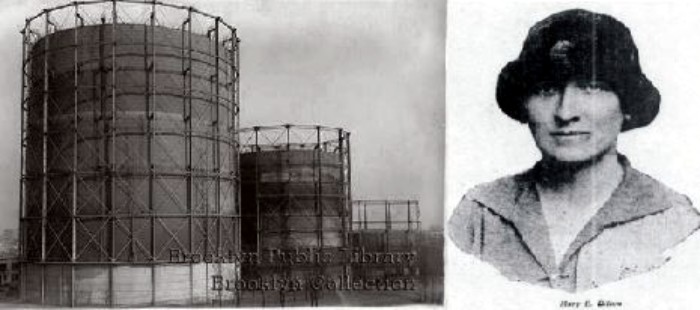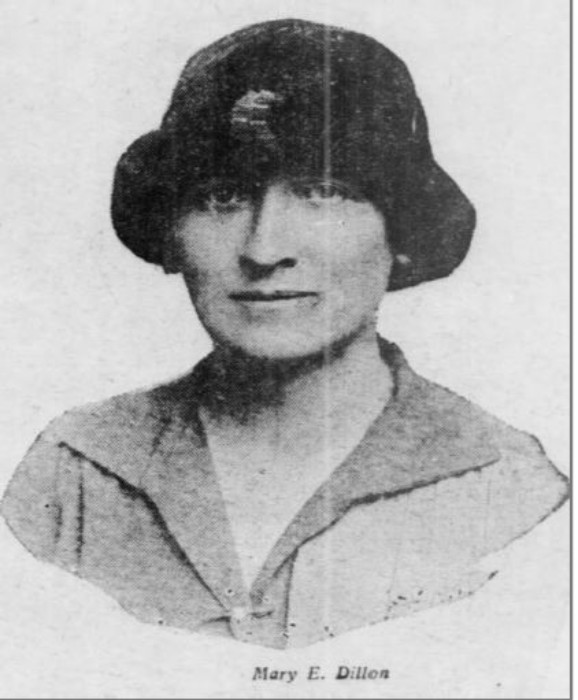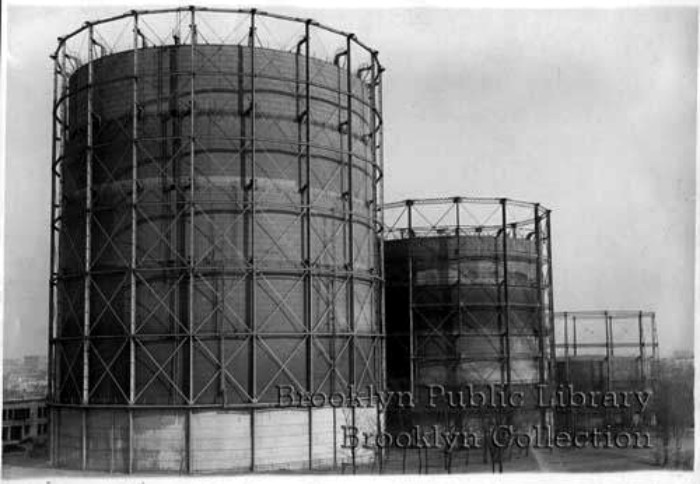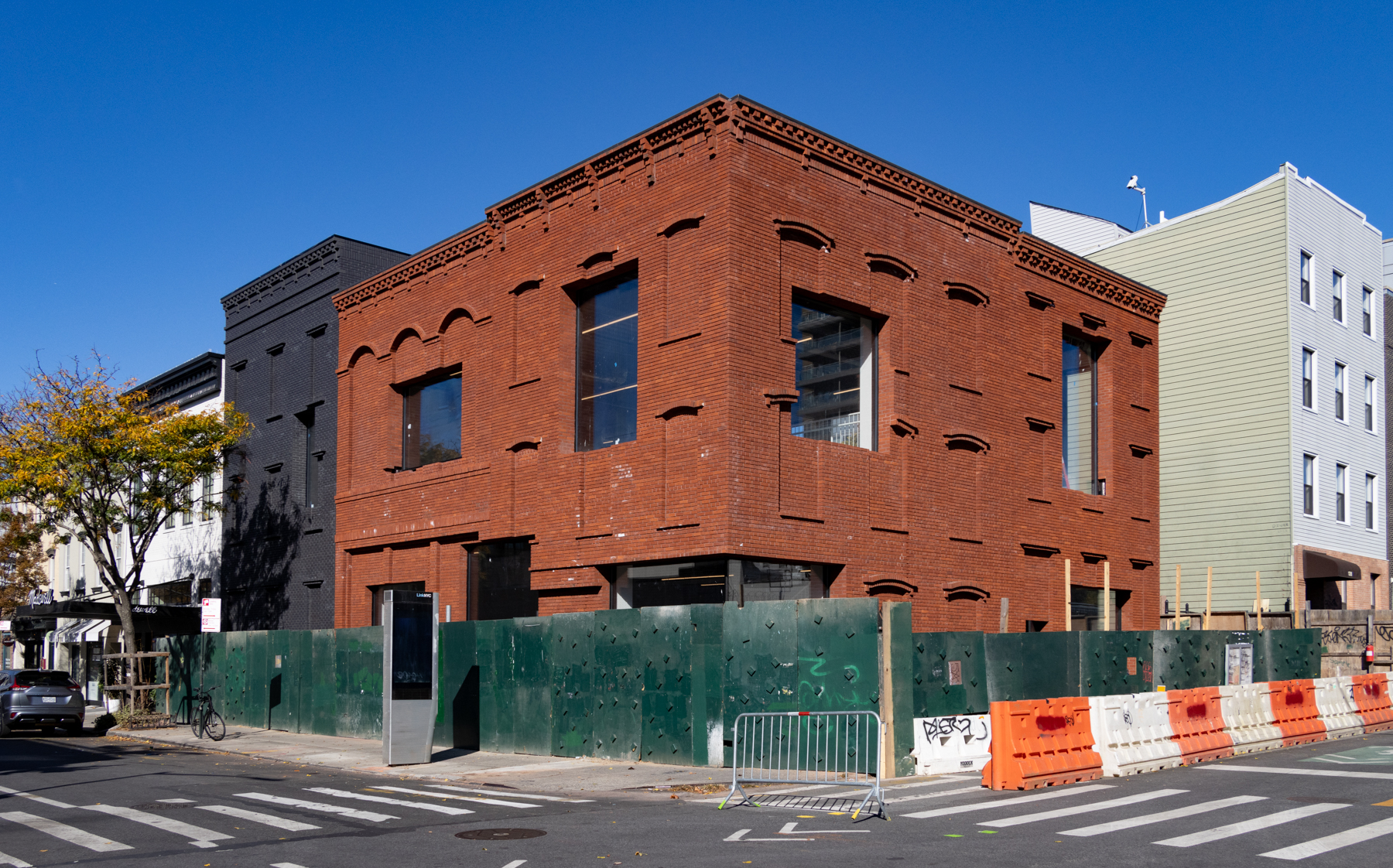Walkabout: Miss Dillon’s Gas Company
Read Part 2, Part 3 and Part 4 of this story. Utility companies are one of the great constants in our lives. Very few of us live in a world where we don’t have to pay Con Edison, National Grid, or another supplier for electricity and gas. Today, natural gas is used primarily for appliances…


Read Part 2, Part 3 and Part 4 of this story.
Utility companies are one of the great constants in our lives. Very few of us live in a world where we don’t have to pay Con Edison, National Grid, or another supplier for electricity and gas. Today, natural gas is used primarily for appliances and heating, but throughout much of the 19th century, gas was THE utility, supplying light, heat and power.
As its use spread throughout the city of Brooklyn, gas companies were established to supply this increasingly necessary utility. Almost every neighborhood had its own gas company, with some neighborhoods served by competing carriers. Each had their own local gas plants, and their own lines which ran below the street and up into individual homes and businesses.
The competition, as you can imagine, was fierce. Everyone wanted to control their neighborhood completely and solely, and most of these companies were looking to expand into other neighborhoods and take them over as well. The more ambitious companies did just that, and by the end of the 19th century, Brooklyn had gone from many gas companies down to only a handful. In 1895, seven of them consolidated to form Brooklyn Union Gas. They reigned in Brooklyn as the largest gas utility until 1998, when Brooklyn Union Gas merged with the Long Island Lighting Company (LILCO) and became the Key Span Company.
Brooklyn Union Gas took over almost all of Brooklyn’s gas utility business. Almost, but not all. There was one holdout – a company that serviced far off Coney Island. This company was not power hungry, and didn’t want to take over other territory; it just wanted to be left alone to service Coney Island, the nearby beach communities and Gravesend. It was called the Brooklyn Borough Gas Company, and it had its headquarters and gas plant on Neptune Avenue in Coney Island.
The history of Brooklyn Borough Gas actually begins in 1877, when the company was founded by a group of entrepreneurs in Greater Brooklyn led by John Lockwood. They staked out the Gravesend section of Brooklyn, and called their new utility the Kings County Gas Company. A Gravesend man became president, but the stockholders were mostly men from other parts of Brooklyn. Gravesend was growing, especially as Coney Island started to become a resort area for the rich, and the plant grew, was expanded, and grew some more.
The name of the company was changed to the Coney Island Gas and Fuel Company. When Brooklyn became part of Greater New York, in 1898, the company changed its name again, this time to the Brooklyn Borough Gas Company. It was owned by a man named J. Edward Atticks. He had had his own grand ideas of consolidating his gas company and any others he could convince to join him, and forming a larger company like Brooklyn Union Gas. He tried to form his conglomerate, but failed.
Unfortunately for him, one of the companies that would become BUG was the Nassau Gas & Light Company, which was owned by Charles Pratt of Standard Oil. Pratt threw the power of Standard Oil into the mix and foiled Atticks at every turn. Atticks didn’t stand a chance against that kind of power, and he gave up his expansion ideas, and settled in with his Coney Island company. In 1899, he sold it to a group of investors from Philadelphia, who reorganized it under the name Brooklyn Gas and Electric Light Company, dba Brooklyn Borough Gas Company. All of the board members and officers of the company were in Philadelphia, while the directors were in Brooklyn.
During the first ten years of the 20th century, the company continued to grow and expand. They petitioned for the right to lay new pipes throughout their territory, and also expand their power plant operation. They also petitioned to offer more common and preferred stock to raise money, and chose a new board of directors. The company, although not as powerful or large as Brooklyn Union Gas, was doing well, and the price of its stock continued to rise. Control of the company came back to officers and board members living in Brooklyn.
Also in Brooklyn as the new century progressed, lived a young woman named Mary E. Dillon. Miss Dillon was a senior at Erasmus Hall High School in Flatbush. She lived on Coney Island, and was the second oldest of twelve children. While still in her senior year at school, had gotten a job at Stauch’s Baths to help the family finances. Stauch’s was one of the large public bathing beaches on the island in the days when most people, male and female, did not own bathing suits.
Men’s suits looked like long underwear, but women’s bathing ensembles were made of black wool, with sleeves and long bloomers with a skirt over that, and enough fabric to drown you. Women were not expected to swim anyway, just stand in the water and splash around to cool off. Stauch’s rented suits for those who came to their part of the beach. They were a very large and busy business.
Mary Dillon’s job was at the suit rental stand. She had only a few minutes to size up a female customer or a child, and pick out a suit that would fit. She earned six dollars a week. She became very good at it, much better than her co-workers, and after a few months, she approached Louis Stauch, her boss, and asked for a dollar raise. He told her she was worth every penny of her six dollars, but that was it. No raise. Mary promptly quit.
It just so happened that her sister was about to leave her job to get married. She was the only female employee at Brooklyn Borough Gas, and worked in the office. Mary had recently won an essay contest sponsored by BBG, and she submitted her essay on Hendrick Hudson as her application for the job. They liked her moxie, and with her sister’s recommendation to boot, Mary Dillon took her place as Brooklyn Borough Gas’ only female employee at ten dollars a week. It was 1903 and she was 17.
Mary knew nothing about the gas business, and started out in the office as the “office boy” as she would later call herself. Anything they asked her to do, she did, and over the next few years, she learned everything about the gas business, from billing to operations. She was like an early movie heroine, a pretty, petite and blonde young woman who made her way in a man’s world. More women were eventually hired in the company, but there were very few women like Mary Dillon.
Three years after being hired, Mary had gone from junior clerk to office manager, at the age of 20. By 1912, she knew the gas business inside and out, from top to bottom. She was so knowledgeable that she was selected by the general manager to be his assistant. Seven years later, her manager left his position. Mary Dillon was the obvious choice to succeed him. She knew more about Brooklyn Borough Gas than anyone else in the company. But she was a woman, by then a 33 year old unmarried woman. It was unheard of that a woman could manage a gas company.
The company was running well. They had weathered some controversies; some customer outrage over billing increases and some government inquiries into their rights to lay pipes in order to expand. (A long story over rights granted in their original charter.) Their stock was on the rise, and was often touted in the papers as one of the better utilities to invest in. The board decided to split the difference. They did not hire another general manager, and allowed Mary to do the job, but without the title.
She no doubt gritted her teeth, and made the decision to wait them out. They would come around. Times were changing, and soon, women would even be allowed to vote. A woman in charge would be possible soon. And she was right. In 1924, the directors finally gave her the title of general manager and vice president of the company. A year later, the company was sold to a new owner, and Mary Dillon was voted in as a member of the board of directors.
Miss Dillon was now in the big office. She had gotten married in 1923 to Henry Farber, a businessman. The couple lived in Sea Gate, close to Mary’s office in Coney Island. She kept her maiden name, however, and throughout her business life always was known as Miss Mary E. Dillon. That was the name on the door, on her checks, on all of her correspondence, and how she was addressed by the business world and the press.
In March of 1926, Mary Estelle Dillon was voted in as President and Chairman of the Brooklyn Borough Gas Company. She was the first woman in the world to head a utility company. The company was worth five million dollars, and had 500 employees and served 170,000 customers. It was the 25th largest utility company in the country. Miss Dillon was at the head of it all. She knew gas and she knew her customers. There were big changes ahead for Brooklyn Borough Gas.
Next time: The role of the homemaker was taking center stage in American society, and the kitchen was the new heart of the home. Mary Dillon was acutely aware of that, and ushered in a new relationship between the utility and the female customer. A new headquarters in Coney Island was a big part of that. The new building and Mary Dillon’s story continues in our next chapter.











What's Your Take? Leave a Comment